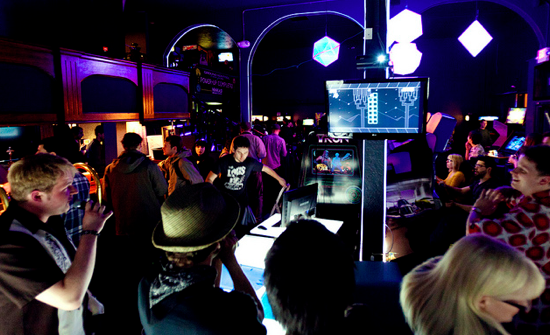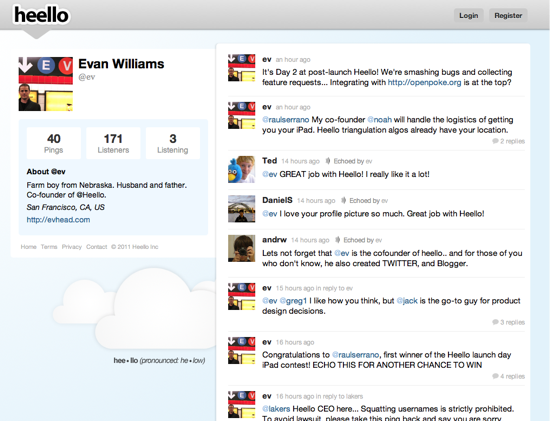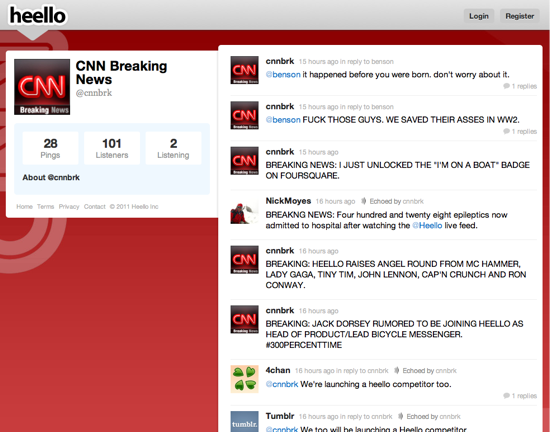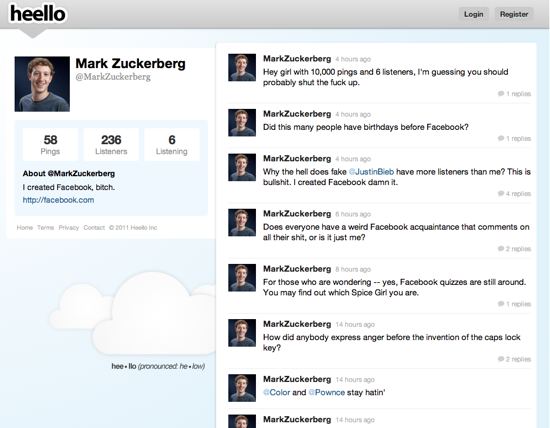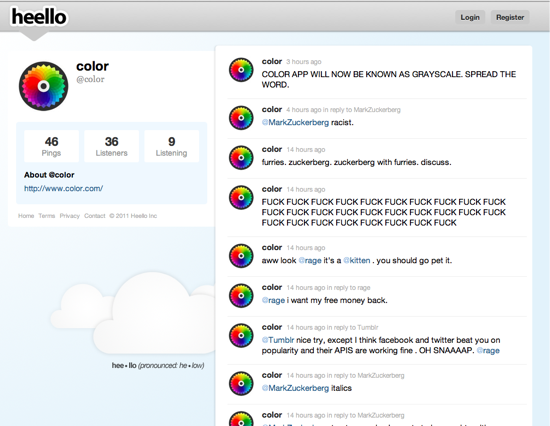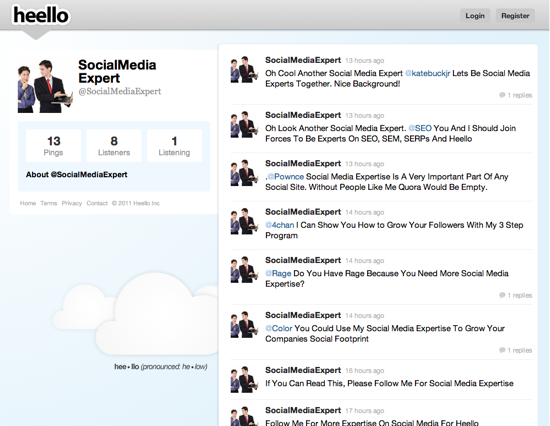I have a bunch of friends coming into town for ROFLCon Summit on Saturday, and rather than email them my suggestions of stuff to do in Portland, I thought I’d make it public.
This is my guide to PDX for people like me: people who geek out about good food, beer, comics, and computers. It’s for people who want to experience the best of Portland in a short period of time, with a heavy focus on new stuff: many of the places listed here have opened in the last year.
One thing you’ll notice is that most of the best stuff isn’t in the downtown area. To really experience Portland, you’ll need to cross the bridge to the east side. But don’t worry, PDX is tiny and nothing will take you more than a few minutes by bus, bike, or taxi.
If you want any other suggestions, or have suggestions of your own, let me know!
View Waxy.org’s Essential Guide to Portland 2011 in a larger map
Restaurants

Tasty n Sons / Tasty n Alder (NE/SW)
If you have to choose one place to eat breakfast in Portland, go here. Imagine tapas-style small plates, but focused only on breakfast staples. A new downtown location brings a slightly different menu throughout the day and evening, both are great but get busy. Brunch daily from 9am.
Meat Cheese Bread and Bunk Sandwiches (SE/SW)
These two restaurants are focused on making the best sandwiches in Portland. If it’s late, try Bunk Bar in inner SE, which brings Bunk’s sandwiches to a bar-like setting.
Salt & Straw (NE/NW)
Tyler Malek’s creative flavors and farm-to-cone ingredients make this the best ice cream around. Try the pear w/blue cheese, honey-strawberry-balsamic with black pepper, or special flavors made with local microbrewed beers. Now with a second location on NW 23rd.
Pine State Biscuits (NE)
Heart-stopping, delicious biscuit sandwiches. I don’t think there’s a bad thing on the menu, but the Reggie and Moneyball are particularly great. If you skip breakfast, their Alberta location stays open until 1am on Fridays and Saturdays. (Their SE Belmont location closed in early 2013, soon to reopen on Division.)
Screen Door (SE)
Portland meets the South, with farm-to-table comfort food. Surprisingly great for vegans, with a menu of local organic sides and salads that changes weekly. Best fried chicken I’ve ever had. Get there before brunch (9am) or dinner (5:30pm), or be prepared to wait.
Apizza Scholls (SE)
Slice ranked it as one of the top five pizzerias in America, and the #2 pizza on the West coast in their March Madness bracket. Just get there when they open, or be ready to saddle up with a couple beers and wait.
Pok Pok (SE)
2011 James Beard-winning chef Andy Ricker kicked off a culinary renaissance in Portland with his frontyard grill-turned-restaurant empire. Inspired by Thai street food, you won’t find chicken panang anywhere near Pok Pok’s eclectic, face-melting menu. While you wait, grab a drink at the Pok Pok-owned Whiskey Soda Lounge across the street. And try a drinking vinegar, you won’t regret it.
Grüner (SW)
Delicious Alpine cuisine, my favorite new restaurant in the downtown area. They also just opened Kask, their newly-opened casual bar adjacent to the restaurant.
Boke Bowl (SE)
My favorite ramen in Portland. Not traditional, but excellent, Boke Bowl started as a series of pop-up ramen events around town before establishing their own location. I highly recommend the steamed buns and the pork ramen w/fried chicken. Vegan and gluten-free ramen options are available and delicious.
Tanuki (SE)
The motto of this quirky Japanese/Korean-influenced izakaya is “No kids, no sushi,” but I’d also add “no groups larger than three, no vegetarians, no picky eaters, no prudes, no prima donnas.” Just get the omakase for $20/person, order some drinks, play some pinball, and enjoy. My favorite restaurant in Portland, and some of the best meals I’ve ever had. Just be willing to go with the flow, or you’ll get your ass banned for life.
Food Carts and Late-Night Dining
The food cart scene in Portland is ridiculously amazing, a food culture revolution with over 670 carts in 25 “pods” (groups of carts), some spanning full city blocks. They can be a little hit-or-miss, but there are some amazing gems to be found. New this year: carts serving beer.
Note: Voodoo Doughnuts is for tourists. Like Le Bistro Montage, Whiffies Fried Pies and Potato Champion, these late-night staples became famous with locals by being open when bars let out. They should only be consumed drunk. (And even then, you can do better.) Any other time, they’re just mediocre. Want great donuts? Try the new Blue Star Donuts, a 10-minute walk from Voodoo.
Pyro Pizza, Whiffies fried pie, and Potato Champion poutine, photo by Stacy Clinton
Nong’s Khao Man Gai (SW)
Bangkok-born Nong Poonsukwattana offers only one item on her menu — khao man gai, a uniquely Thai street dish made from poached chicken and rice and sauce. Arguably the best cart in Portland, located at the sprawling SW 9th and Alder cart pod, the largest in town spanning two blocks. Closed Sundays. (Too busy? Try the to-go shop in SE.)
Cartopia (SE, weekends until 3am)
This collection of carts on SE Hawthorne at 12th is more known for its late-night hours and raucous vibe than the quality of its food. But if you’re hungry after a late night of drinking, it’s definitely worth trying Pyro Pizza’s wood-fired oven-in-a-cart and the crepes from Perierra Creperie.
Since the closure of SE Division’s D Street Noshery, this is probably the best-curated cart pod in the city. Highlights include Minizo (ramen), Miss Kate’s Southern Kitchen, The Big Egg (breakfast until 2pm), Koi Fusion (Korean-Mexican fusion), and Prickly Ash (Chinese flatbread sandwiches). On a nice day, grab your food and sit on Prost’s deck with some oversized Belgian beers.
Drinking
Portland’s a big beer town, home to more microbreweries than any city in the world, though the distillery and cocktail scene’s grown in recent years. Here are my picks for the absolute best.
Hair of the Dog Brewing, Photo by throgers
Hair of the Dog (SE)
This microbrewery is beer geek heaven, capturing five out of RateBeer’s top six Oregon beers. A perfect place to try some of Portland’s best beer, though their tasting room has quirky hours, open only from 2-8pm, Wednesday through Sunday.
APEX (SE)
50 great beers on tap and a massive patio. Grab some excellent Portland-style banh mi from Double Dragon across the street, and settle in. Cash only, but if you use their ATM and show the receipt, they’ll give you $1 off.
Bye & Bye/Sweet Hereafter (NE/SE)
The Bye & Bye on NE Alberta and the Sweet Hereafter, its newly-opened sister on SE Belmont, are distinctly Portland institutions — vegan bars with food that’s shockingly tasty even for die-hard omnivores like me (try the chili pie!). Great beer list, delicious and strong cocktails served in Mason jars, comfortable vibe, and plenty of seating make this a great meeting place.
Bailey’s Taproom (SW)
There isn’t much atmosphere here, but Bailey’s makes up for it with the most interesting taplist in Portland — 20 beers rotating daily, selected by mega-beer geeks.
Green Dragon (SE)
With 50 beers on tap and huge indoor/outdoor spaces, this place is great for meeting large groups of people. The food menu and taplist can be hit-or-miss, but there’s always a handful of great beers in the mix. If you’re feeling experimental, try Cascade Brewing across the street, one of the few breweries in the U.S. focused on sour ales.
Distillery Row (SE)
If you’re here on a weekend, take an hour to sample Portland’s craft distillery movement on foot, doing tastings from House Spirits and Eastside Distilling to New Deal and Vinn. If you can only choose one, New Deal’s the best deal, with eight excellent liquors for $5.
There’s no shortage of phenomenal coffee in Portland. (Coava is my personal pick.) But I’m not a big coffee drinker so I tend to head to Townshend’s, the best tea in Portland. Their bubble tea is best in town, with a wide range of flavors and your pick of tapioca, aloe or fruit jellies.
Attractions
Ground Kontrol at night, photo by Incredible Ape
Ground Kontrol (NW)
World-class ’80s video arcade and pinball gallery that turns into a 21+ bar after 5pm. Absolutely essential geek visit.
Everyone knows about Powell’s Books, but geeks may be more interested in Powell’s Technical, an essential resource for modern and vintage books on science, math, computers, and engineering. It recently relocated directly across the street from the flagship store.
Portland has some great comic shops, but for art/indie/experimental comic lovers, Floating World can’t be missed.
Counter Media (SW)
On the other side of Burnside from Powell’s, Counter Media is a wonderful bookstore carrying a carefully-curated collection of indie comics and graphic novels, with crazy fetish stuff in the back.
Billy Galaxy (SW)
Though often wildly overpriced, this is nostalgia heaven. Go buy that Burgertime lunchbox you’ve always wanted.
Want more?
Looking for late-night options? I did a big roundup of the city’s best, as of May 2013.
The recommendations from Eater’s Top Restaurants and Heatmaps are consistently solid.
Have a great time!



